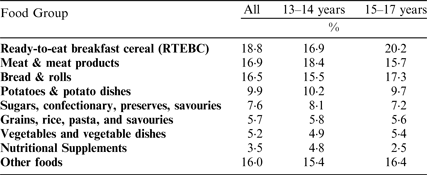The teenage years are a period of significant growth and development with increased iron requirements for females. Recent data from the UK shows that teenage girls have low intakes of iron and there is evidence of anaemia and low iron stores in this group(Reference Bates, Cox and Nicholson1). The objective of this study was to estimate the dietary intake, adequacy, sources and dietary determinants of iron in Irish teenage girls aged 13–17 years. Analyses were based on the Irish National Teen's Food Survey (2005–2006) (www.iuna.net), which used a 7-day semi-weighed food record to collect food and beverage intake data from a nationally representative sample of 441 adolescents (224 males, 217 females). Dietary intakes were analysed using WISP© (Tinuviel Software, Anglesey, UK), which is based on McCance and Widdowson's The Composition of Foods, Sixth Edition (2). For the purpose of this analysis, participants taking iron supplements containing >100 mg of iron were excluded (n = 4). Usual intakes of iron were calculated via the NCI-method(Reference Tooze, Kipnis and Buckman4) using SAS© Enterprise Guide. The proportion of the population with intakes below the estimated average requirement (EAR)(3) of 7 mg/d was determined excluding energy under-reporters. SPSS© v22 was used to calculate the key sources of iron by the population proportion method(Reference Krebs-Smith, Kott and Guenther5) and dietary determinants of iron intake. On the basis of mean daily intake of iron, participants were divided into three intake groups: low, medium or high. The food groups that accounted for the greatest proportion of the difference between the high (top third) and low (bottom third) of iron intakes were identified.
Table 1. Contribution (%) of food groups to iron intake in Irish girls (13–17y)

Table 2. Dietary determinants of iron intake in Irish girls (13–17y)

* from food sources and supplements
The mean daily intake of iron in teenage girls aged 13–17 years was 9·4 mg/d and 41% had intakes below the EAR. The key sources of iron in teenage girls were ‘ready-to-eat breakfast cereals’ (RTEBC), ‘meat & meat products’ and ‘bread & rolls’ which contributed 17–19% of intakes. The difference in mean iron intakes between high and low consumers was 8·4 mg/d, of which RTEBCs accounted for 41%, nutritional supplements 25% and ‘bread & rolls’ 8%. While ‘meat & meat products’ were an important source (17%) of iron, this food group accounted for only a small proportion of the difference in intakes between high and low consumers (6%). These findings show that a significant proportion of girls aged 13–17 years have low intakes of iron and will aid in the development of dietary strategies to improve intakes of iron in teenage girls in Ireland.
This research was funded by the Irish Department of Agriculture, Food and the Marine under the project ‘National Children's Food Consumption Survey II’ (15/F/673).






